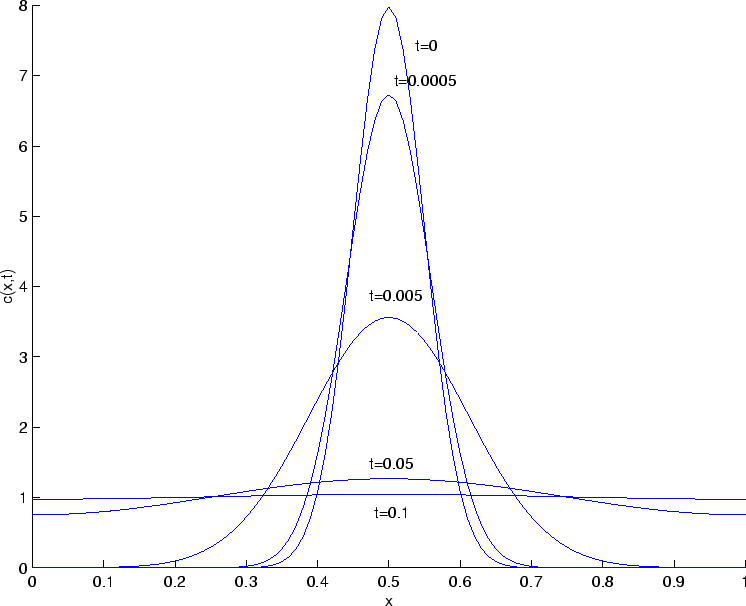For no-flux boundary conditions, we want
![]() .
Notice that
.
Notice that


Note that since no flux leaves the boundaries, conservation of mass
implies that
The following Matlab code solves the diffusion equation according to the scheme given by (5) and for no-flux boundary conditions:
numx = 101; %number of grid points in x
numt = 2000; %number of time steps to be iterated
dx = 1/(numx - 1);
dt = 0.00005;
x = 0:dx:1; %vector of x values, to be used for plotting
C = zeros(numx,numt); %initialize everything to zero
%specify initial conditions
t(1) = 0; %t=0
mu = 0.5;
sigma = 0.05;
for i=1:numx
C(i,1) = exp(-(x(i)-mu)^2/(2*sigma^2)) / sqrt(2*pi*sigma^2);
end
%iterate difference equations
for j=1:numt
t(j+1) = t(j) + dt;
for i=2:numx-1
C(i,j+1) = C(i,j) + (dt/dx^2)*(C(i+1,j) - 2*C(i,j) + C(i-1,j));
end
C(1,j+1) = C(2,j+1); %C(1,j+1) found from no-flux condition
C(numx,j+1) = C(numx-1,j+1); %C(numx,j+1) found from no-flux condition
end
figure(1);
hold on;
plot(x,C(:,1));
plot(x,C(:,11));
plot(x,C(:,101));
plot(x,C(:,1001));
plot(x,C(:,2001));
xlabel('x');
ylabel('c(x,t)');
%calculate approximation to the integral of c from x=0 to x=1
for j=1:numt+1
s(j) = sum(C(1:numx-1,j))*dx;
end
figure(2);
plot(t,s);
xlabel('t');
ylabel('c_{total}');
axis([0 0.1 0.9 1.1]);
 |
We see that the solution eventually settles down to ![]() being uniform
in
being uniform
in ![]() . Because of the normalization of our initial condition, this
uniform state is given by
. Because of the normalization of our initial condition, this
uniform state is given by ![]() . We also notice that
. We also notice that ![]() is not quite
constant in time - this must be a result of numerical error (both
in our finite difference scheme and our numerical calculation of integrals,
etc). We could get a better result with different choices of
is not quite
constant in time - this must be a result of numerical error (both
in our finite difference scheme and our numerical calculation of integrals,
etc). We could get a better result with different choices of ![]() and
and ![]() , or by using a more sophisticated finite difference scheme.
, or by using a more sophisticated finite difference scheme.